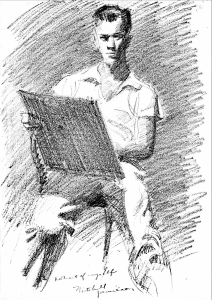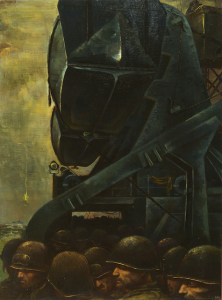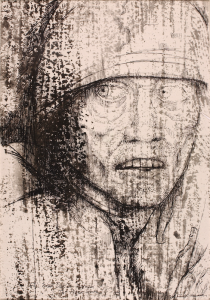
Biography
In many ways Mitchell Jamieson's life and career paralleled the history of 20th century America - its triumphs and its tragedies. Jamieson was born in 1915 and educated at the Abbot School of Fine and Commercial Arts and the Corcoran Art School. With support from the Treasury Department Art Project he travelled to Key West and the US Virgin Islands. He won a competition to paint a mural for the Post Office in Upper Marlboro, Maryland in 1938 and travelled to Mexico City the next year to meet the muralists working there. In 1940 he was selected to create a mural commemorating Marian Anderson's performance at the Lincoln Memorial, an early milestone in the Civil Rights Movement.
In 1941 Jamieson received a commission for a Post Office mural in Willard, Ohio. Enlisting in the US Navy, he embarked on a tour of duty as a combat artist that took him across all fronts of the war. He painted the invasion of Sicily, the D-Day landings, Iwo Jima and the Japanese surrender on the USS Missouri. Following the war, Jamieson received an Award in Art from the American Academy of Arts and Letters and two Guggenheim Fellowships. Beginning in 1949, he undertook teaching positions at a number of schools, ending up in 1959 at the University of Maryland. Meanwhile his work was in demand from national publications. From 1963-1972 he worked on commissions from NASA to help document the US space program.
All in all, this was a distinguished career, with assignments that tracked the high points of American achievement. But in 1967 Jamieson was asked to spend a month in Vietnam to record his impressions of the war then raging in Southeast Asia. Unlike his portrayals of the action in World War II, where he celebrated fortitude, bravery and camaraderie, Jamieson's work in Vietnam was unrelentingly harsh and condemnatory of the brutal scenes he witnessed in that country. Jamieson did not hide his sentiments about the War in Vietnam and titled his series on that war as "The Plague."
While Jamieson's stay in Vietnam was only a month long, and while he continued his NASA assignments after this tour, he was emotionally shattered by the experience, which may have undermined everything he had felt about the United States. He died by suicide in 1976.



Critical Analysis
Jamieson was a brilliant illustrator and watercolorist, as is evident in the vast number of works that have been preserved from his years of service in World War II. It is interesting to contrast his murals in Upper Marlboro and Willard, the first painted before his sojourn in Mexico City and the second after his exposure to the Mexican muralists. Aside from the change from a bucolic topic to an industrial one, Jamieson infused the later painting with considerably more energy and action.
His painting of the Marian Anderson concert, "An Incident in Contemporary American Life," goes a step beyond his early murals. While achieving a scale appropriate to the crowd of 75,000 people who attended Marian Anderson's famous concert, Jamieson's composition brings individual portraits into the foreground of the painting, suggesting that each of the 75,000 attendees may have brought their own personal story and perspective.
Jamieson's World War II work stands on its own - rapidly generated work that nonetheless conveys both the emotional tenor and brutal truth of wartime action. And his portfolio of "The Plague" in Vietnam may perhaps be compared with Goya's "Disasters of War" as an indictment of man's ultimate cruelty.
Murals
- Washington, District of Columbia - Department of The Interior: An Incident in Contemporary American Life
- Upper Marlboro, Maryland - Prince George's County Library: Tobacco Cutters
- Willard, Ohio - Post Office: The Roundhouse at Willard
References
- Christopher Eger, D-Day Through the Brush of a GI Who Was There, 75 Years Ago Today, Last Stand on Zombie Island June 6 (2019).
- Paul Richard, Darkened Drawings From a Prisoner of Wars, Washington Post December 7 (1979).
- District of Columbia: Mitchell Jamieson Mural (National Park Service).
- Mitchell Jamieson (Wikipedia).
- Mitchell Jamieson (1915-1976) (Naval History and Heritage Command).
- Mitchell Jamieson Watercolor w/ Draper Dedication (Artemis Gallery).
- Bert Ulrich, NASA and the Arts, Rick on Theater 06 December (2018).
- Bayli Mohl, Post-Modern: Influence of The Vietnam War, Explorations in Art (2017).
- Paul K, Space Age Art, BibliOdsyssey June 12 (2012).